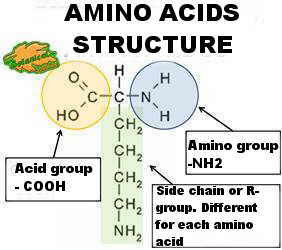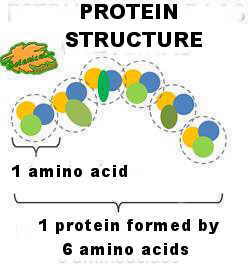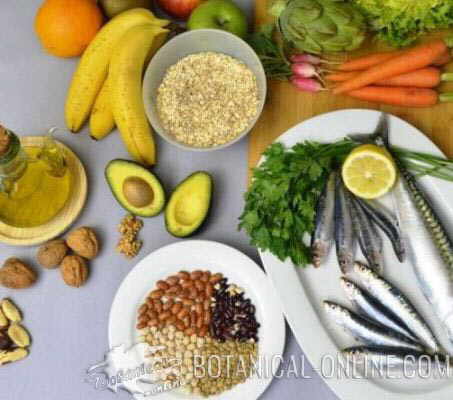Contents
- 1 What do proteins consist of?
- 1.1 HOW ARE PROTEINS FORMED
- 1.2 Chemical structure of proteins
- 1.3 Where and how proteins are formed?
- 1.4 Essential amino acids and nonessential amino acids
- 1.5 List of amino acids in food
- 1.6 Protein formation in the liver
- 1.7 Have the protein an acidic or basic effect?
- 1.8 Protein foods with acidifying action
What do proteins consist of?
HOW ARE PROTEINS FORMED
|
Chemical structure of proteins
Proteins are formed by the union of several hundreds or thousands of amino acids.
Chemically, they contain the same atoms as carbohydrates or fats, such as carbon, hydrogen and oxygen, but, unlike these, proteins contain nitrogen, and sometimes sulfur (sulfur-containing amino acids as methionine).
Amino acids are joined together forming peptides (binding of several amino acids) or polypeptides (tens or hundreds of amino acids). The union of several polypeptides form macromolecules called proteins.
The breakdown of proteins into smaller molecules down to amino acids is called hydrolysis.
Where and how proteins are formed?
Each cell in the body produces its own proteins, from the information contained in its genetic code (DNA).
The DNA of each person is originated from the union of his/her parental sex cells (DNA from sperm and DNA from egg cell). Cells reproduce again and again until forming a person with millions of cells, containing in their nucleus that DNA.
Every cell in the body, according to their functions, produces one kind or another protein.
For example, eye cells reproduce information from DNA that tells them how to make a protein for blue eyes. Another person, will have the information for green eyes.
All body proteins (collagen, insulin, enzymes, etc.) are originated from the DNA in the nucleus of a cell.
To make proteins, the body, in addition to the information in DNA, needs a substrate or a kind of “bricks”. Amino acids are this substrate. They can be obtained from food, or made by the body itself from some substances
Essential amino acids and nonessential amino acids
There are 9 essential amino acids that the body can not develop them by itself. These amino acids must be obtained through the food we eat.
Nonessential amino acids can be synthesized by the body without having to include in the diet, from amino acids or other substances.
List of amino acids in food | |
Essential amino acids | Nonessential amino acids |
Phenylalanine, Isoleucine, Leucine, Lysine, Methionine, Threonine, Tryptophan, Valine | Aspartic acid, Glutaminic acid, Alanine, Arginine, Cysteine, Cystine, Glycine, Hydroxyproline, Proline, Serine, Tyrosine |
Other amino acids | |
Protein formation in the liver
The liver is the organ capable of developing non-essential amino acids from food ingested through our diet, depending on the needs that our body has. In addition, it also has high enzymatic capacity.
Liver functions related to proteins are:
– Production of certain proteins needed for proper state of blood plasma
– Protein production to properly transport fats (lipoproteins)
– Regulation of amino acid levels in the blood
– Processing hemoglobin and storing iron
– Transformation of the resulting toxic substances, as ammonia, into urea, in order to remove them by the kidneys.
– Regulation and production of enzymes to modulate our immunity.
It is essential to provide protein to the liver so that it can perform all these functions as necessary, among many others, in order not to generate any deficiencies in our body.
It is considered the liver one of the most resilient organs of our body, a “national laboratory”. It takes much of vital metabolic functions, including greatly intervention in many amino acids and proteins.
This organ is able to operate up to a third of its length and it is the only organ that self-regenerates. This entails many advantages and a major drawback because, being so strong and not showing signs of dysfunction, it is usually too late to fix the problem when it stops working properly.
Have the protein an acidic or basic effect?
Thanks to the forming structure, proteins are amphoteric, that is to say, they behave as acids or bases depending on the medium in which they are.
We must not confuse their chemical properties with its acidifying effect on the body, because they usually have nothing to do.
Protein foods with acidifying action
Some foods that we ingest have acidifying effect on our body. They are meat, seafood, cereals, pasta, rice, bread, milk and dairy products, nuts, caffeinated beverages such as coffee or colas,… the less acidifying of foods providing significant levels of protein are: fish, eggs, beans and almonds.
Some foods that have an basifying effect on in our body. They are potatoes and sweet potatoes, vegetables, fruits and citrus fruits, dried fruits,…
Foods with sour taste have not necessarily an acidifying effect. A clear example of acidic flavor foods that have the opposite bassifying effect on our body are citrus.
We must maintain a balance, consuming two foods with basifying effect for every acidic food, without forgetting to meet our protein needs, so that we can preferably consume the less acidifying food, if we have an excess of acidification.
* Related information:
– How to combine vegetable proteins
![]() More information on amino acids.
More information on amino acids.










